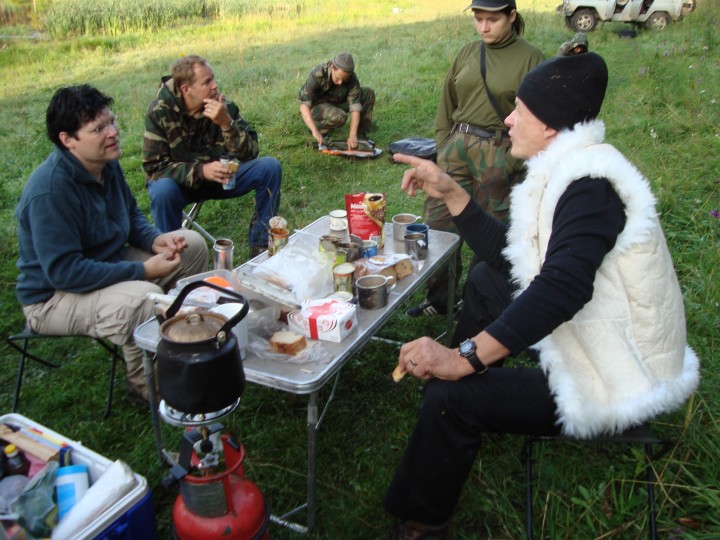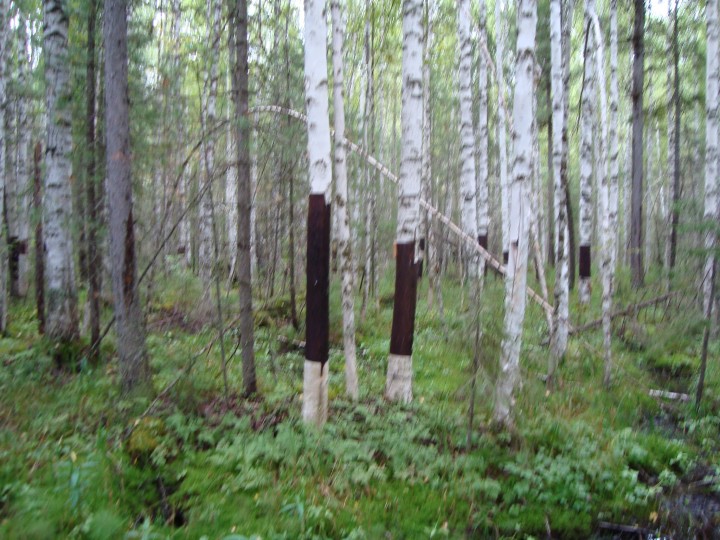Stepanova, Siberia 58.67 N 86.76 E
10:35 pm Siberia local; 11:35 pm next day EST
High 74 F Low 52 F Scattered rain
It has been another day in camp for me. I am feelin a little better, but my head is still stopped up and that makes it hard to exert myself. I don’t think I’m all that sick, really. If I was going to the office, no problem. But here, in the Siberian forest, everything requires a huge physical effort. And when you’re sick, even walking fifty yards is an effort all by itself. Expeditions and colds just don’t mix.
They did a great job today, as usual. Pasha, Ross, Sergei, Bruce and Marsha spent a long day in the forest, and came back with 16 plots measured. That’s a great day’s work. They report that the sites were fairly dry and the dominant species was Scots Pine. I hear that there are some amazing Aspen – some at least 100 years old. I have to say that this crew works really hard, and they work extremely well together. Everyone is tired, but in a good mood. Thanks to them, this expedition is making up for lost time.

When the body won’t work, the mind can still think. I’ve spent the day thinking about the importance of expeditions like these. It costs a lot of money to get everyone here. It takes everyone away from our lives and their families. And it’s really hard work. We don’t come here for fun. Yes, we enjoy ourselves when we can, but, at the heart of it, this is very serious business and hard business, too.
So I was thinking today about all the sacrifices we make to get out here, a half of a world away from home, just to make these measurements in the forest. I was wondering if it was worth it all. And the answer is unequivocal: yes.
Sometimes scientists and policy makers sit in their comfortable offices, looking at data from our remote-sensing instruments, and thinking that’s really all we need. Sometimes it slips our mind that people are living in these forests, and relying on them for their own lives. And sometimes we forget that there is a lot more knowledge on the Earth than can be gathered remotely. It is only by getting into the forests and getting onto the land that we connect with reality. And we need to talk to people, too. People that live with the land – like the Siberians we’ve met, have an incredible amount of knowledge about the forest. They have a lot to share with us. And they are greatly affected by forest policy as well, so our data can impact their lives.
The Siberians we’ve met are helpful, friendly people. They give us gifts, offer us hospitality, give us directions and are quick to laugh with us. We all are here in this forest at this time for our own reasons. But in the end, we’re really all just trying to do what is the most important to us – take care of our own lives, take care of our families and take the best care we can of our forests and our Earth. While they live day-to-day within this forest, we are trying to understand this same environment, to keep it healthy and viable, long term.
So as different as we are, we are connected through this forest. A few days ago I felt very connected to the past, as we worked forests that the kulaks had worked. Yesterday we connected with the past again as the harvesters cut the grass by hand, just as Slava’s grandfather had done, and generations before him. Today I realize that the forest doesn’t just connect us to the past, it connects those who live a half a world away, in the present, despite our very different lives.
The forest connects us to the future, too. It is here, in the forest, where carbon is taken up at a high rate, and that may be a key to living on this earth without destroying it – to care for the carbon sequestration to keep the earth in balance. Caring for the forest is, in a very real way, caring for our future.
Sometimes the forest is called “the lungs of the world” –and in a way that is true. The forest is a living entity, one which helps keep our Earth clean and temperate through its very existence. If we can use our data to learn more about this forest, and to help policy makers make decisions to better manage this essential part of life as we know it, then we are making a real contribution to the health of our future.
This expedition is allowing us to study very different forests than we saw in 2007 and 2008. We were in extremely remote areas then. The forests were in a more natural state, so we were studying mainly natural changes and climate changes, with less direct influence from humans. Here the forests are heavily used by people. We can study the effects of human influence on the forest. As someone said in camp today – in years past, we were in the middle of nowhere. Now we are just on the edge. It’s a different world, and we are learning a great deal about human-forest interaction.

There was some excitement in camp this morning. Two men arrived on a little motorcycle with a wooden sidecar. In the sidecar was an inflatable boat. They blew it up, carried it to the river, went to the other side, and started fishing. They were pretty quiet about it all, and didn’t chat with us. I guess they were catching something, but we couldn’t see what.
So we decided we’d better go see what they were catching. We haven’t caught any fish at all this trip, which means there has been no fish soup. That was a staple in prior expeditions, so we’d like to have at least a taste this year. To make fish soup, one takes a whole fish, chops it up, and throws it in a pot with onions and seasonings. That’s dinner. In years past, it was also sometimes breakfast and lunch, too. This year, we’ve missed the key ingredient: fresh fish.
Whatever the success on the other side of the river, we had no luck here. The only thing I caught was a six-inch Northern Pike. Might sound like something, but pike are so skinny that it looked like a cigar. He was cute, but not big enough to flavor soup, so I let him go. Slava shook his head, saying he’d just go tell his buddies that we were here trying to catch them, and we’d get no more fish today. And that is exactly how it worked out – one cigar, and no more.
I heard that there was a little misunderstanding on the way back from the forest. The crew decided to stop at a store to get some supplies. Bruce had bought some bottled water in Tomsk, and wanted more. I think it’s called Bon Aqua. He went into this little shop, showed the keeper the bottle, and lifted his finger up in “one” sign, hoping she would sell him one bottle of Bon Aqua. After a moment, she smiled and graciously took the bottle from him, went to the tap, and filled it up. Bruce called the Russian-speakers over to help, but it was just no good. Not only was there no bottled water, but the shopkeeper just could not imagine why anyone in their right mind would want to buy water, when the best water in the world was to be found, free, in Stepanova. Apparently, the town is world-famous for mineral springs and healing water. I guess we are the talk of the town tonight, as those folks who came to the best water in the world, and wouldn’t drink.
Well, if it’s healing water, I’ll be drinking it. We’re going to stay here for at least one more day and night. There are many GLAS footprints nearby, and it’s most efficient to stay put, without wasting more time on rough road. Between the rest and the mineral water, maybe I’ll be fit to work tomorrow.




3 dimensional imagery is available which allows measurement of tree height. There are a number satellites which produce stereo image pairs. These can be viewed with free software and have sufficient accuracy to pinpoint forest height within 2 meters.
http://www.satimagingcorp.com/svc/ikonos-stereo-satellite-images.html
is one example.
Hope you had a good time in your camp there.
Regards from Germany
Michael